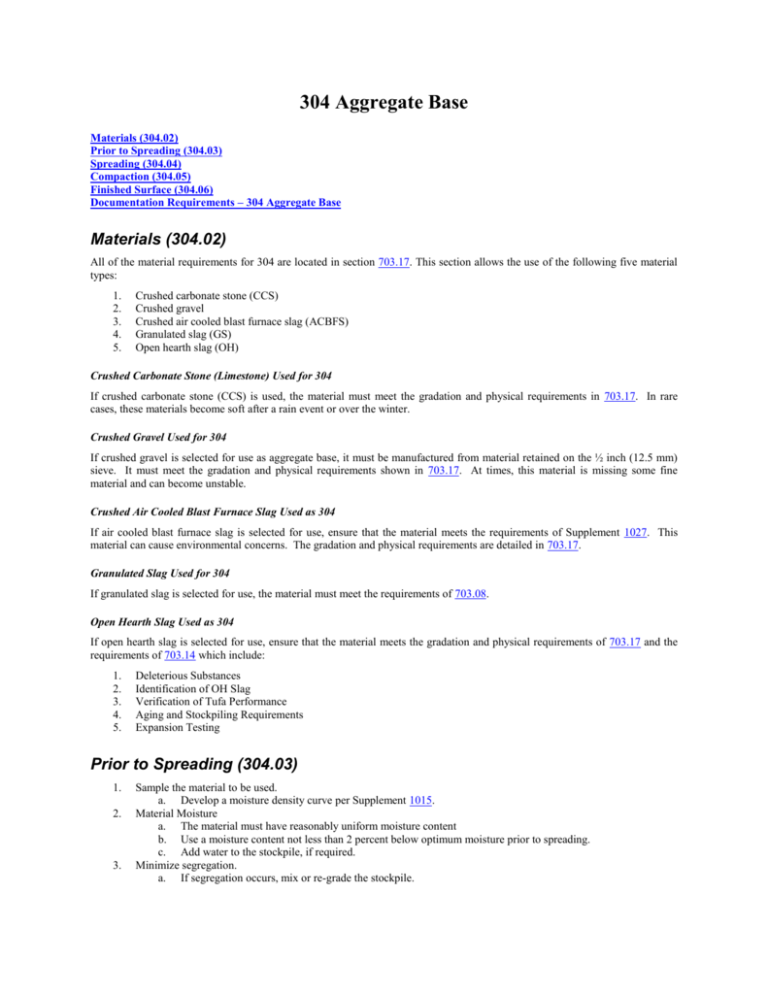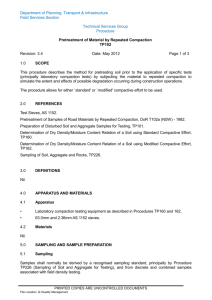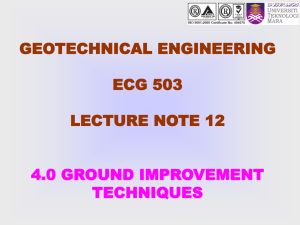304 Aggregate Base
advertisement

304 Aggregate Base Materials (304.02) Prior to Spreading (304.03) Spreading (304.04) Compaction (304.05) Finished Surface (304.06) Documentation Requirements – 304 Aggregate Base Materials (304.02) All of the material requirements for 304 are located in section 703.17. This section allows the use of the following five material types: 1. 2. 3. 4. 5. Crushed carbonate stone (CCS) Crushed gravel Crushed air cooled blast furnace slag (ACBFS) Granulated slag (GS) Open hearth slag (OH) Crushed Carbonate Stone (Limestone) Used for 304 If crushed carbonate stone (CCS) is used, the material must meet the gradation and physical requirements in 703.17. In rare cases, these materials become soft after a rain event or over the winter. Crushed Gravel Used for 304 If crushed gravel is selected for use as aggregate base, it must be manufactured from material retained on the ½ inch (12.5 mm) sieve. It must meet the gradation and physical requirements shown in 703.17. At times, this material is missing some fine material and can become unstable. Crushed Air Cooled Blast Furnace Slag Used as 304 If air cooled blast furnace slag is selected for use, ensure that the material meets the requirements of Supplement 1027. This material can cause environmental concerns. The gradation and physical requirements are detailed in 703.17. Granulated Slag Used for 304 If granulated slag is selected for use, the material must meet the requirements of 703.08. Open Hearth Slag Used as 304 If open hearth slag is selected for use, ensure that the material meets the gradation and physical requirements of 703.17 and the requirements of 703.14 which include: 1. 2. 3. 4. 5. Deleterious Substances Identification of OH Slag Verification of Tufa Performance Aging and Stockpiling Requirements Expansion Testing Prior to Spreading (304.03) 1. 2. 3. Sample the material to be used. a. Develop a moisture density curve per Supplement 1015. Material Moisture a. The material must have reasonably uniform moisture content b. Use a moisture content not less than 2 percent below optimum moisture prior to spreading. c. Add water to the stockpile, if required. Minimize segregation. a. If segregation occurs, mix or re-grade the stockpile. Spreading (304.04) The 2008 C&MS contains an incorrect version of 304.04. See Supplemental Specification 800 (Boilerplate) for the correct version. 1. 2. 3. 4. Do not spread on frozen surfaces. Do not use frozen material. Do not exceed a compacted lift thickness of: a. 8 inches (200 mm) when using vibratory rollers greater than 12 tons (11 metric tons). b. 6 inches (200 mm) with vibratory rollers weighing 10 to 12 tons (9 to 11 metric tons). c. 4 inches (100 mm) with no vibratory roller. If the contractor is compacting with a vibrating plate compactor, the maximum lift thickness is 4 inches. If the contractor is compacting with a roller without any vibration, the maximum lift thickness is 4 inches. d. Can use a lighter roller with equivalent centrifugal force. e. Centrifugal force is the weight with vibration. f. Contractor needs to document the roller weight requirements are met. Place in equal lifts when the specified thickness exceeds 8 inches (200 mm). a. Example: if 12-inch lift is specified, place in two 6 inch lifts. Spreading 304 with a Dozer and Spreader Box Spreading 304 with an Asphalt Paver 5. Use self-propelled spreading machines. a. Capable of placing the 304 material true to line and grade. b. Use a dozer with a spreader box or an asphalt paver. i. This operation prevents segregation. ii. If an area appears to be segregated, take in place gradation tests according to Supplement 1090. iii. Contractor is only allowed to use dozers without spreader boxes or graders or hand-placing methods when the total area of the aggregate base is 2000 square yards or less, or in small areas. Do not take in-place gradation tests in small areas. Spreading 304 with a Dozer May Result in Segregation Spreading 304 with a Grader May Result in Segregation Compaction (304.05) Adding Water to 304 Prior to Compaction Compacting 304 with Vibratory Roller 1. 2. Add water or dry out the material. a. To bring material to within 2 percent of the optimum moisture content. b. Add water or dry the 304 prior to compaction. i. Material is too dense to add water after compaction. c. Maintain moisture during compaction. d. Uniformly apply water throughout the lift. e. Reduce when unstable. Compact immediately after spreading. Construct a Test Section Perform the Compaction Tests 3. Construct a short test section. a. Compaction testing according to Supplement 1015. b. Use a minimum of eight passes in the test section. i. Minimizes getting a false maximum. 4. Use and adjust the vibration. a. Maximize density and stability. b. When vibration at maximum can make any material unstable. 5. Use 98 percent for the acceptance in the production area. a. Take 3 tests in the lot for acceptance. b. Use the average of the results. 6. Use at least: a. Same number of passes and compactive effort used to obtain the test section maximum density for the production material. i. Increases passing results in the production area. 7. At a minimum, use eight passes in the production area. a. Increases passing results. 8. Reduce minimum passes if detrimental. a. Do not over roll it may cause cracking. 9. Construct a new test section when. a. Material changes. b. Supporting materials change (e.g. Go from natural soil to cement stabilized subgrade). 10. Check production material density. a. Before or after the finishing operations. 11. Maintain the surface a. So that the texture is: i. Reasonably uniform. ii. Aggregate firmly keyed. iii. Hauling on the 304 will ‘Un-key’ the material. 12. Scheduling 304 operations a. Cover the aggregate base with the next pavement layer prior to the end of the construction season. b. If the contractor doesn’t pave before the end of the construction season, then the Contractor is responsible for contamination, damage and instability of the base, subgrade and underdrains. 13. Provide drainage and maintain the material according to 203.04.A. a. Maintain the cross slope. b. If it rains or material sits over the winter. i. Dry the 304 and subgrade. ii. Obtain and maintain stability and density. Finished Surface (304.06) 1. 2. Finished surface so that does not vary: a. More than 3/8 inch (10 mm). i. From a 10-foot (3 m) straightedge parallel to the centerline. b. Or more than 1/2 inch (13 mm). i. From a template conforming to the required cross-section. Contractor to furnish straightedges, templates, or other devices. Checks of the Depth (304.06) 1. 2. At the beginning of the spreading operation. a. Contractor must adjust the spreader. i. Produce sufficient loose depth to meet plan compacted thickness. 1. Determined after compaction. ii. Make occasional checks. 1. During the spreading to ensure uniform depth after compaction. b. Purpose is to control spreading. i. Need not be recorded. After fine grading: a. Make depth checks. i. At 500 ft. (150 m) intervals. ii. Extended to 1,000 ft. (300 m) if depth is consistent and meets plan depth. b. Some variation in depth is expected. i. Tolerance of 3/4 in. (19 mm) between individual measurements. c. If consistently less by any amount. i. Requirements have not been met. ii. Take corrective action. d. If individual measurement. i. Less than 3/4 in. (19 mm) of plan depth. 1. Make measurement within 100 ft. (30 m). 2. If greater than plan thickness. a. Satisfactory. 3. If less than plan thickness. a. Make checks at additional locations. b. Define deficient area. c. Require correction. e. Record all depth measurements. i. With station locations. ii. Place in the project records. Checks of the Width (304.06) 1. 2. Measurements of the width of base. a. Need not be made prior to placement of overlying courses because the width of base can readily be verified. After the overlying pavement is placed make a visual verification of the base width. a. If it conforms to or exceeds the plan width. File a statement in the project records. Documentation Requirements - 304 Aggregate Base 1. 2. 3. 4. 5. 6. 7. 8. 9. Materials Roller weights Record lift thickness Segregation. Roller passes Perform the compaction tests according to S-1015 Verify cross section and thickness. In place gradation tests according to S-1090, if required. Obtain weight ticket, if required. Tickets should be totaled with initialed and dated tape attached. Convert to cubic yards (cubic meters) as per 304.07 of the C&MS 10. Pay and measure according to 304.07 and 304.08 11. Document on the CA-EW-12 and CA-D-1 and CA-D-2. Do not duplicate the information on these forms unless necessary.







